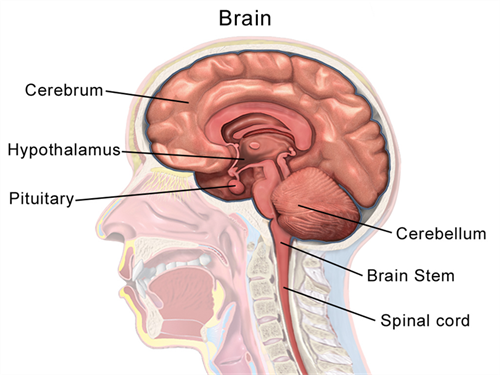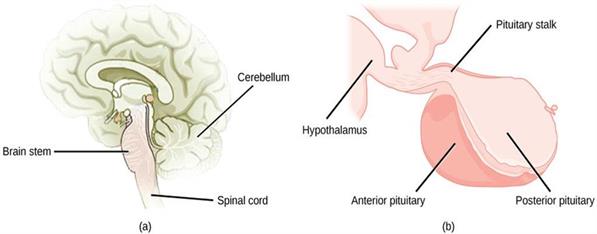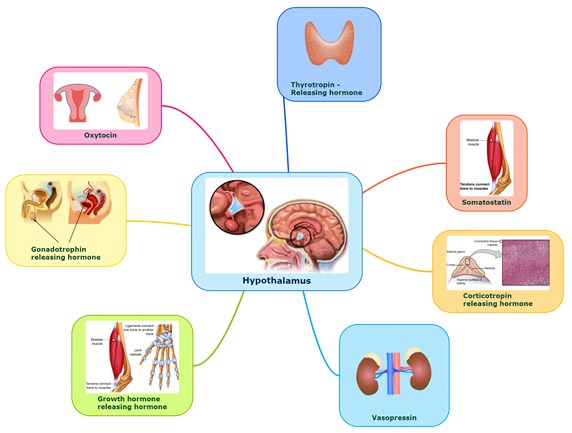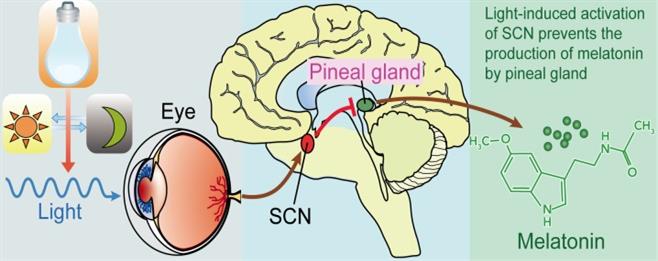
PUMPA - SMART LEARNING
எங்கள் ஆசிரியர்களுடன் 1-ஆன்-1 ஆலோசனை நேரத்தைப் பெறுங்கள். டாப்பர் ஆவதற்கு நாங்கள் பயிற்சி அளிப்போம்
Book Free DemoThe endocrine system comprises endocrine glands, and the hormone-producing diffused tissues or cells distributed throughout our bodies.
The hypothalamus, pituitary, pineal, thyroid, adrenal, pancreas, parathyroid, thymus, and gonads (testis in males and ovary in females) are the endocrine glands in our bodies.
Both the nervous system and endocrine hormonal system helps in the control and coordination of the body. If we consider the nervous system, it gets the sensory inputs from the environment through the receptors and processes them in the brain.
Now the question arises, where does the endocrine system get the sensory inputs to perform its functions. It is also getting inputs from the nervous system, and the hypothalamus acts as a link between the nervous system and endocrine system via the pituitary gland.
Hypothalamus

Hypothalamus
The hypothalamus develops from the embryo's ectoderm.
Hypothalamus is the most basal portion of the diencephalon and forebrain, and it controls a wide range of bodily activities. It is regarded as the endocrine system's supreme commander.
Hypothalamus contains nuclei, which are groupings of neurosecretory cells that produce hormones called neurohormones.
These hormones control pituitary hormone production and secretion. The hypothalamus is an anatomical link between the nervous and endocrine systems.

Attachment of hypothalamus with pituitary gland
The hypothalamus secretes two different types of hormones: releasing hormones (which stimulate pituitary hormone release) and inhibitory hormones (which inhibit pituitary hormone secretion). These hormones originate in hypothalamus neurons and are released from their nerve terminals - axons.
The hypothalamus secretes a variety of hormones. They are
|
Hormone
|
Function
|
| Thyrotropin-releasing hormone (TRH) | It stimulates the anterior lobe of the pituitary to secrete the hormone thyrotropin or thyroid-stimulating hormone (TSH). |
| Adrenocorticotropin releasing hormone (ARH) | It stimulates the anterior lobe of the pituitary to secrete adrenocorticotropic hormone (ACTH). |
| Somatotrophin releasing hormone (SRH) | SRH stimulates the anterior lobe of the pituitary to release the growth hormone (GH) or somatotropin. |
| Prolactin releasing hormone (PRH) | PRH stimulates the anterior lobe of the pituitary to release prolactin. |
| Prolactin inhibiting hormone (PIH) | PIH inhibits the prolactin secretion from the anterior lobe of the pituitary gland. |
| Growth inhibiting hormone (GIH) | GHIH is called somatostatin (SS). SS inhibits the secretion of growth hormone (GH) from the anterior lobe of the pituitary. |
| Melanocyte stimulating hormone (MSH) | MSHRH stimulates the intermediate lobe of the pituitary to secrete the melanocyte-stimulating hormone (MSH). |
| Melanocyte inhibiting hormone (MIH) | MSHIH inhibits the secretion of MSH from the intermediate lobe of the pituitary gland. |
| Gonadotrophin releasing hormone (GRH) |
GnRH stimulates the anterior lobe of the pituitary to secrete the two gonadotropic hormones: follicle-stimulating hormone (FSH) and luteinising hormone (LH).
|
-
These hormones travel through the circulatory system to the pituitary gland, regulating the hormones generated by the anterior and middle lobes. The hypothalamus controls the posterior pituitary by direct neural regulation.

Hormones released by hypothalamus
The hypothalamus secretes oxytocin and vasopressin (Antidiuretic hormone). These hormones are stored in the posterior lobe of the pituitary gland.
The video explaining the role of the hypothalamus and the pituitary gland
Apart from the basic five senses, humans have many more senses that help control the body. One of them is the sense of time. How our body identifies the day and night cycle? How our body identifies the time to sleep and time to wake? Our body consists of a biological clock that helps in the function of rhythmic cycles.
The hormone which is responsible for the governance of the biological clock is Melatonin.
Pineal gland
The pineal gland is a gland located at the base of the brain. It develops from the embryo's ectoderm. It is found on the forebrain's dorsal side.
Pineal glands are sometimes known as epiphysis cerebri. Melatonin is a hormone that it secretes.
Pineal glands are sometimes known as epiphysis cerebri. Melatonin is a hormone that it secretes.

Location of pineal gland
Melatonin is a hormone produced by the pineal gland. Melatonin is a hormone that governs the "biological clock".
- It indicates that melatonin controls our body's 24-hour (daily) rhythm. For example, it keeps the sleep-wake cycle and body temperature in check.
- It also impacts metabolism, pigmentation, the menstrual cycle, and the ability to defend oneself. Pineal sand is calcium deposits seen in the pineal gland.

Activation of melatonin
Important!
- Endocrinology is the study of endocrine glands and the functions of their secretions.
- An endocrinologist is a doctor who specialises in endocrine glands.
Reference:
https://upload.wikimedia.org/wikipedia/commons/thumb/8/86/Brain_Anatomy_%28Sagittal%29.png/1024px-Brain_Anatomy_%28Sagittal%29.png
https://upload.wikimedia.org/wikipedia/commons/thumb/5/56/Figure_37_05_01ab.jpg/1024px-Figure_37_05_01ab.jpg
https://upload.wikimedia.org/wikipedia/commons/7/71/Blausen_0536_HypothalamusLocation.png
https://commons.wikimedia.org/wiki/File:201405_thyroid_gland.png
https://upload.wikimedia.org/wikipedia/commons/0/06/201405_mammary_gland.png
https://commons.wikimedia.org/wiki/File:Male_and_female_gonads.svg
https://upload.wikimedia.org/wikipedia/commons/4/48/201405_kidney.png
https://www.savingstudentsmoney.org/OLI/AnPpost.html
https://upload.wikimedia.org/wikipedia/commons/c/ca/1818_The_Adrenal_Glands.jpg
https://upload.wikimedia.org/wikipedia/commons/thumb/5/56/Figure_37_05_01ab.jpg/1024px-Figure_37_05_01ab.jpg
https://upload.wikimedia.org/wikipedia/commons/7/71/Blausen_0536_HypothalamusLocation.png
https://commons.wikimedia.org/wiki/File:201405_thyroid_gland.png
https://upload.wikimedia.org/wikipedia/commons/0/06/201405_mammary_gland.png
https://commons.wikimedia.org/wiki/File:Male_and_female_gonads.svg
https://upload.wikimedia.org/wikipedia/commons/4/48/201405_kidney.png
https://www.savingstudentsmoney.org/OLI/AnPpost.html
https://upload.wikimedia.org/wikipedia/commons/c/ca/1818_The_Adrenal_Glands.jpg
https://upload.wikimedia.org/wikipedia/commons/7/79/Pineal_Gland_Poster.jpg
https://www.shutterstock.com/de/image-vector/pineal-gland-anatomical-cross-section-vector-1097435906